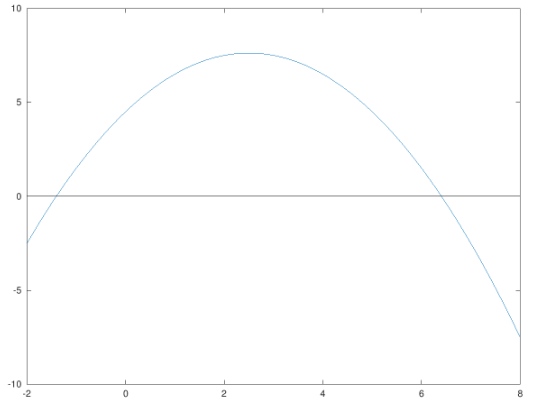
Determine the real roots of
(a) Graphically.
(b) Using the
(c) Using three iterations of the bisection method to determine the highest root. Employ initial guesses of
Compute the estimated error
(a)
The real roots of the equation
Answer to Problem 1P
Solution:
The real roots of the equation are
Explanation of Solution
Given Information:
The equation
Calculation:
The graph of the function can be plotted using MATLAB.
Code:
Output:
This gives the following plot:

The roots of an equation can be represented graphically by the x-coordinate of the point where the graph cuts the x-axis. From the plot, the two zeros of the equation can be approximated as
(b)
To calculate: The real roots of the equation
Answer to Problem 1P
Solution:
The roots of the equation are
Explanation of Solution
Given Information:
The equation
Formula Used:
The roots of an equation
Calculation:
Consider the provided equation,
Now substitute
Thus, the roots of the equation are
(c)
To calculate: The highest root of the equation
Answer to Problem 1P
Solution:
The highest root of the equation can be approximated as 6.875. The true and approximate errors are as follows:
Explanation of Solution
Given Information:
The equation
Formula Used:
A root of an equation can be obtained using the bisection method as follows:
1. Choose 2 values x, say a and b such that
2. Now, estimate the root by
3. If,
Calculation:
For the provided function:
Hence,
Now take the first root to be,
As, the true root computed from part (b) was 6.40512484. Now, the true relative percentage error would be:
The true error is 17.1%. There would be no approximate error for the first iteration.
Now,
Thus,
Now, the second root would be:
As, the true root computed from part (b) was 6.40512484. Now, the true relative percentage error would be:
The true error is 2.42%.
The approximate error can be computed as:
The approximate error is 2%.
Now,
Thus,
Now, the third root would be:
As, the true root computed from part (b) was 6.40512484. Now, the true relative percentage error would be:
The true error is 7.34%.
The approximate error can be computed as:
The approximate error is 9.09%.
Thus, the highest root can be approximated as 6.875.
Want to see more full solutions like this?
Chapter 5 Solutions
EBK NUMERICAL METHODS FOR ENGINEERS
- 1. Evaluate the following improper integrals: (a) fe-rt dt; (b) fert dt; (c) fi da dxarrow_forward8. Given the rate of net investment I(t) = 9t¹/2, find the level of capital formation in (i) 16 years and (ii) between the 4th and the 8th years.arrow_forward9. If the marginal revenue function of a firm in the production of output is MR = 40 - 10q² where q is the level of output, and total revenue is 120 at 3 units of output, find the total revenue function. [Hints: TR = √ MRdq]arrow_forward
- 6. Solve the following first-order linear differential equations; if an initial condition is given, definitize the arbitrary constant: (a) 2 + 12y + 2et = 0, y(0) = /; (b) dy+y=tarrow_forward4. Let A = {a, b, c, d, e, f}, B = {e, f, g, h} and C = {a, e, h,i}. Let U = {a, b, c, d, e, f, g, h, i, j, k}. • Draw a Venn Diagram to describe the relationships between these sets Find (AB) NC • Find (AC) UB Find AUBUC • Find (BC) N (A - C)arrow_forward7. A consumer lives on an island where she produces two goods x and y according to the production possibility frontier x² + y² < 200 and she consumes all the goods. Her utility function is U(x, y) = x y³. She faces an environmental constraint on her total output of both goods. The environmental constraint is given by x + y ≤20. • (a) Write down the consumer's optimization problem. (b) Write out the Kuhn-Tucker first order conditions. (c) Find the consumer's optimal consumption bundle (x*, y*).arrow_forward
- 3. Answer the following questions: (a) Given the marginal propensity to import M'(Y) = 0.1 and the information that M = 20 when Y = 0, find the import function M(Y). (b) Given a continuous income stream at the constant rate of $1,000 per year, what will be the present value II if the income stream terminates after exactly 3 years and the discount rate is 0.04? (c) What is the present value of a perpetual cash flow of $2,460 per year, discounted at r = 8%?arrow_forward5. Let A and B be arbitrary sets. Prove AnB = AUB.arrow_forward2. Answer the following questions: (a) Given the marginal-revenue function R'(Q) = 28Q - €0.3Q, find the total-revenue function R(Q). What initial condition can you introduce to definitize the constant of integration? = (b) Given the marginal propensity to consume C'(Y) 0.80.1Y-1/2 and the information that C = Y when Y = 100, find the consumption function C(Y).arrow_forward
- 7. Let X, A, and B be arbitrary sets such that ACX and BC X. Prove AUB CX.arrow_forward1. Write out the following sets as a list of elements. If necessary you may use ... in your description. {x EZ: |x|< 10 A x < 0} {x ЄN: x ≤ 20 A x = 2y for some y = N} {n EN: 3 | n^ 1 < n < 20} {y Є Z: y² <0}arrow_forward3. For each statement below, write an equivalent statement using the justification given. = y Є A or yЄ B by the definition of union = y Є A or y Є B by the definition of set complement = x = C and x & D by DeMorgan's Law =Vx (x EnFxЄEUF) by definition of subset. = (X CYUZ)A (YUZ CX) by definition of set equalityarrow_forward
- Algebra & Trigonometry with Analytic GeometryAlgebraISBN:9781133382119Author:SwokowskiPublisher:Cengage




